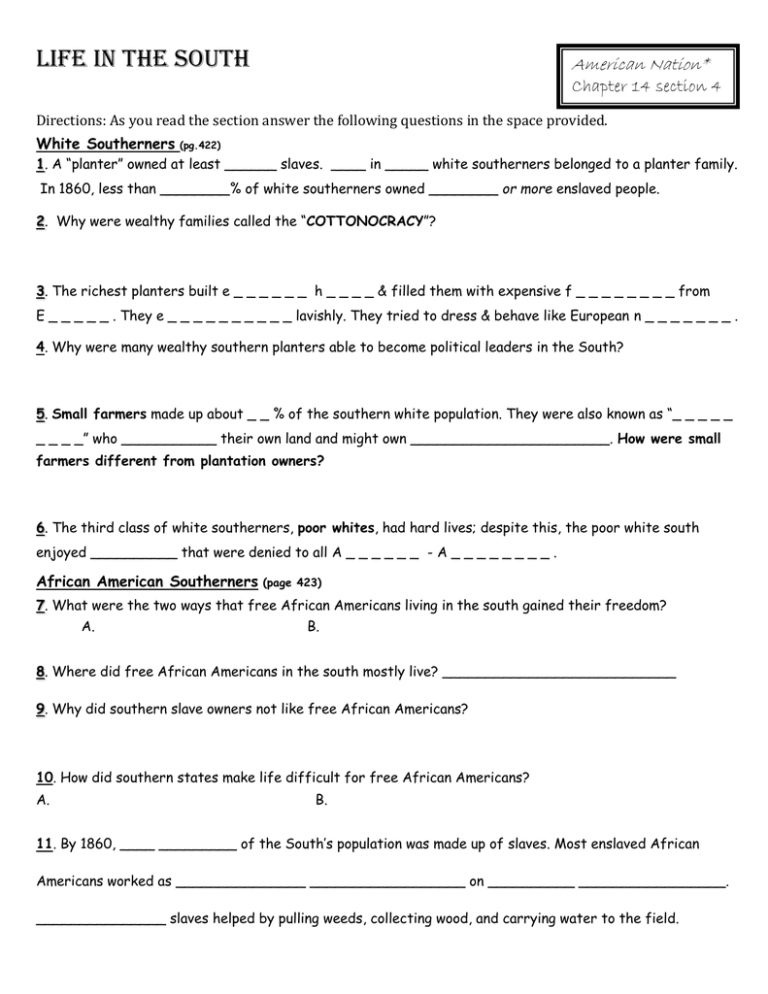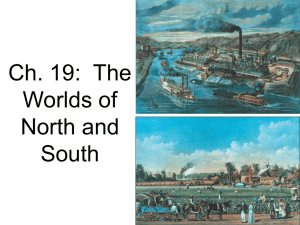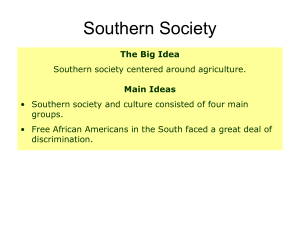Life in the South American Nation* Chapter 14 section 4
advertisement

Life in the South American Nation* Chapter 14 section 4 Directions: As you read the section answer the following questions in the space provided. White Southerners (pg.422) 1. A “planter” owned at least ______ slaves. ____ in _____ white southerners belonged to a planter family. In 1860, less than ________% of white southerners owned ________ or more enslaved people. 2. Why were wealthy families called the “COTTONOCRACY”? 3. The richest planters built e _ _ _ _ _ _ h _ _ _ _ & filled them with expensive f _ _ _ _ _ _ _ _ from E _ _ _ _ _ . They e _ _ _ _ _ _ _ _ _ _ lavishly. They tried to dress & behave like European n _ _ _ _ _ _ _ . 4. Why were many wealthy southern planters able to become political leaders in the South? 5. Small farmers made up about _ _ % of the southern white population. They were also known as “_ _ _ _ _ _ _ _ _” who ___________ their own land and might own _______________________. How were small farmers different from plantation owners? 6. The third class of white southerners, poor whites, had hard lives; despite this, the poor white south enjoyed __________ that were denied to all A _ _ _ _ _ _ - A _ _ _ _ _ _ _ _ . African American Southerners (page 423) 7. What were the two ways that free African Americans living in the south gained their freedom? A. B. 8. Where did free African Americans in the south mostly live? ___________________________ 9. Why did southern slave owners not like free African Americans? 10. How did southern states make life difficult for free African Americans? A. B. 11. By 1860, ____ _________ of the South’s population was made up of slaves. Most enslaved African Americans worked as _______________ __________________ on __________ _________________. _______________ slaves helped by pulling weeds, collecting wood, and carrying water to the field. Life Without Freedom (page 424) 12. Below, list SOME of the RESTRICTIONS created by the slave codes. (FINISH THE SENTENCE ) A. African Americans were forbidden to gather in … B. They could not leave their owner’s … C. They were not allowed to … D. Slave codes also made it a crime for slaves to … E. African Americans did not have the right to testify in … 13. What was the only “protection” African Americans had against their owners? 14. Why was denying African Americans how to read and write a form of keeping them enslaved? 15. Slaves worked long, hard days from “________ ____ to _________ _____” which meant __________ to _____________. 16. It was hard for enslaved African Americans to keep their families together because Southern law did not recognize _______________ or slave families. So owners could ________________ families and sell children . Despite this, _________________ was a source of strength for slaves. How did enslaved people keep other traditions alive? 17. How did religion offer slaves hope as well? Resistance Against Slavery (page 426) 18. In resisting slavery, some African Americans broke ________, destroyed _____________, and stole _____________. Many tried to escape to the North. The journey north was difficult for runaway African Americans; as a result very ________ made it. Part of the reason it was difficult for African Americans to make the journey to freedom was because every southern county had s _ _ _ _ p _ _ _ _ _ _ & s_ _ _ _ _ _ _ ready to question an unknown black person. 19. What did the following slaves do to resist slavery? What was the impact of their actions? a. Denmark Vesey b. Nat Turner





